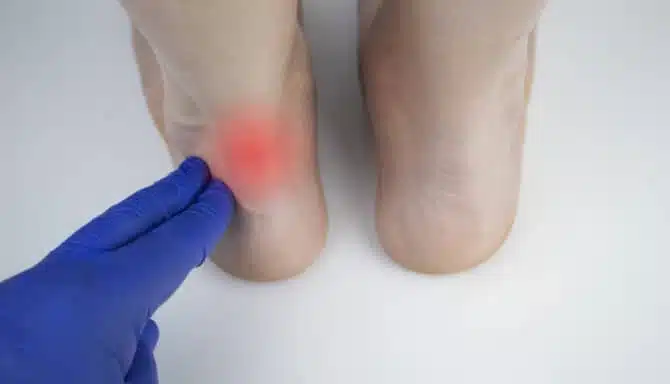Foot injuries can increase in cold weather, so it’s important to learn how to minimize your risk, practice fall prevention, and navigate slippery conditions. Not only that, but cold weather can cause muscle stiffness to worsen, making your feet more vulnerable than they were during the warmer months. Today we’ll talk about 3 safety tips—recommended by the foot specialists at our Toronto foot clinic—to prevent winter foot injuries.
3 Tips to Prevent Winter Foot Injuries
- Wear The Right Shoes
- Try Warm Ups and Foot Exercises
- Wear Supportive Insoles

1. Wear The Right Shoes
The wrong winter boots can lead to numerous foot injuries. While fashion may be your top priority, you shouldn’t sacrifice protective and supportive features just for looks (plus, you can find fashionable and comfortable shoes at our Toronto foot clinic). Winter footwear should have good shock absorption and be made with waterproof materials. Avoid pointed toes and high heels in the winter—these features are a recipe for slips and falls!
Stability And Motion Control Shoes
Did you know there are different foot types, and your foot type can determine what shoes you should wear? For example, people with flat feet need extra stability or motion control features built into their shoes to help correct varying degrees of overpronation (when the ankle rolls inward during movement). A foot specialist, like a podiatrist or chiropodist, can assess your feet and tell you what type shoes you should be wearing:
Stability Shoes
- Purpose: Stability shoes are aimed at those with mild to moderate overpronation (the inward rolling of the foot when walking or running).
- Features: These shoes typically have a supportive structure and posting around the arch and midsole to help guide the foot through a natural gait cycle and promote natural foot motion.
Motion Control Shoes
- Purpose: These are designed for people with severe overpronation, providing maximum support to prevent excessive inward rolling of the foot.
- Features: Motion control shoes are more rigid and structured than stability shoes, with reinforced areas in the midsole.
How does this link back to winter foot safety? If you have flat feet, especially if you’re a senior, and your feet overpronate, your hips, knees and ankles can weaken and become more painful and vulnerable due to years of walking with an abnormal gait. If you don’t have strong feet and joints, icy conditions become that much more threatening.
Both stability and motion control shoes can help prevent winter foot injuries by providing extra support and control in conditions where icy, wet, or uneven surfaces make slips and strains more likely. Keep in mind these should also have solid traction performance!
Traction Performance
High traction performance in shoes (thick, rubber soles with grooves) is essential for winter injury prevention. It prevents slips and falls, which are especially common on icy or wet surfaces. Without reliable traction, even the smallest patch of ice can turn into a serious hazard, causing the foot to slide out from under the body and throwing balance off entirely. This can lead to falls, which are a primary cause of winter injuries, including sprains, fractures, and ligament tears in the foot, ankle, or knee.
Good traction provides a stable, controlled grip on unpredictable surfaces, allowing each step to connect firmly with the ground. This stability reduces the risk of unexpected slips and ensures that the foot can maintain contact without sliding, even on slippery patches. People who enjoy running during the winter months should particularly focus on finding running shoes with traction. Many brands, like Saucony or ASICS, design shoes for this purpose. You can also add on ice cleats or cramp-ons to your footwear for extra grip when running on icy surfaces.
When looking for traction performance, keep in mind that no shoes are built for traction on ice (although some may fare better than others). Only ice cleats or cramp-ons will provide proper grip on ice.

2. Try Warm-ups And Foot Exercises
Before going for a run, warm up your feet and lower extremities with a nice, healthy stretch or foot exercise. This will prepare your feet for pounding the pavement (or snow) and give them an added layer of strength and protection. Runners should be doing this year round as part of their foot care routine, not just during the winter!
These routines are not just for runners! Quite the opposite, in fact; they help people with mobility constraints and inflamed, weakened and damaged muscles/joints just as much as they do athletes.
People with arthritis in the feet, plantar fasciitis and other conditions can help reduce their risk of winter injuries by strengthening their feet. For example, arthritis can lead to joint pain, stiffness, and reduced range of motion, making it challenging to maintain balance on slippery or uneven surfaces. On the other hand, plantar fasciitis involves inflammation of the plantar fascia, the ligament that runs along the bottom of the foot. The discomfort may lead to altered walking mechanics, such as favoring one foot over the other, which can compromise stability and increase the risk of falls.
Stretches and exercises should target the intrinsic (small, stabilizing muscles located within the foot) and extensor muscles (primarily found in the lower leg), and your ankles. Your routine should include a variety of movements that target as many muscle groups as possible.
Here are a few easy, effective stretches and exercises you can start today:
- Toe Splays: While seated or standing, spread (or “splay”) your toes as wide apart as possible, holding for a few seconds, then releasing. Repeat this 10–15 times per foot.
- Toe Flex and Raise: Stand with toes planted and lift the heels off the ground. This exercise strengthens the lower leg and foot muscles, improving balance and stability on icy surfaces.
- Ankle Circles: Sit or stand and slowly rotate each ankle in circles, first clockwise and then counterclockwise. This helps increase ankle mobility and flexibility, which can reduce the risk of sprains.
- Seated Hamstring Stretch: Sit on a chair, extend one leg straight in front. Lean forward slowly until you feel the stretch in your hamstring. Hold for about 30 seconds.
In addition, click here for part 1 and part 2 for the best exercises for arthritis, and here for the best exercises for plantar fasciitis.
The Importance of Balance
We all know the direct link between losing your balance and sustaining an injury. We also know that people with disabilities or conditions that impact mobility need to be extra vigilant. With every step, strong balance allows you to react as quickly as possible to unexpected changes in winter terrain and surfaces, which will keep you safe.
Here are two simple foot exercises that focus on improving balance:
- Single-Leg Stands: Stand on one foot for 20–30 seconds, then switch. This exercise builds balance and strengthens the muscles around the ankle, reducing the risk of falls on uneven surfaces.
- Heel-to-Toe Walk: Walk in a straight line, placing the heel of one foot directly in front of the toes of the other. This exercise improves balance and strengthens stabilizing muscles.
3. Wear Supportive Insoles
Winter footwear is typically built for the elements – not for comfort. Therefore, it can be very difficult to find a supportive winter boot that will also protect your feet from winter weather. Fortunately, if you wear a supportive insole with your footwear, you won’t need to sacrifice comfort for function. There are two types of supportive insoles you can wear with winter footwear: customer orthotics and over-the-counter insoles.
Custom Orthotics
Custom orthotics are designed to fit the unique contours of an individual’s feet, helping to redistribute pressure and provide the necessary arch support. This is especially beneficial for individuals with flat feet or other conditions. Add winter to the mix, and this becomes even more crucial. By optimizing foot alignment, custom orthotics help maintain stability and balance, allowing individuals to navigate slippery surfaces with greater confidence.
Custom orthotics can be made to fit in winter boots or winter running shoes, to keep your foot supported in all scenarios. They can even come in half-lengths to accommodate dress shoes for when you’re leaving the office and heading to your car (slippery sidewalks are everywhere in winter, so you can’t be too careful!). They provide cushioning that absorbs impact and reduces strain on the joints, particularly the ankles and knees, which are crucial during winter activities like walking, shoveling snow, or participating in winter sports.
To learn if you can benefit from custom orthotics, you can consult a foot specialist like a chiropodist or a podiatrist.
Check out these resources on custom orthotics to learn even more:
- 5 Ways Orthotics Can Be Customized for Maximum Comfort and Support
- The Role of Orthotics in Supporting Foot Health and Correcting Alignment
- Understanding Different Types of Custom Orthotics: How to Choose the Right Support for Your Feet
Over-the-Counter Insoles
Over-the-counter insoles, like Superfeet, are also a great option to upgrade your winter footwear. Superfeet insoles have a deep heel cup, pronounced arch and a rigid, durable structure. They come in a variety of arch heights and cushioning levels to accommodate many foot conditions, like high arches, flat feet, plantar fasciitis and more! Whereas custom orthotics are custom-designed to your foot, Superfeet come in standard sizes and designs (each representing a different colour). They therefore can be more economical than custom orthotics.
If you’re interested in Superfeet insoles, bring your winter shoes to our Toronto foot clinic. You can then try different Superfeet options to see which one works best for you. Different insoles feel different in different shoes, so we strongly recommend trying on your Superfeet with your winter shoes before purchasing them.














